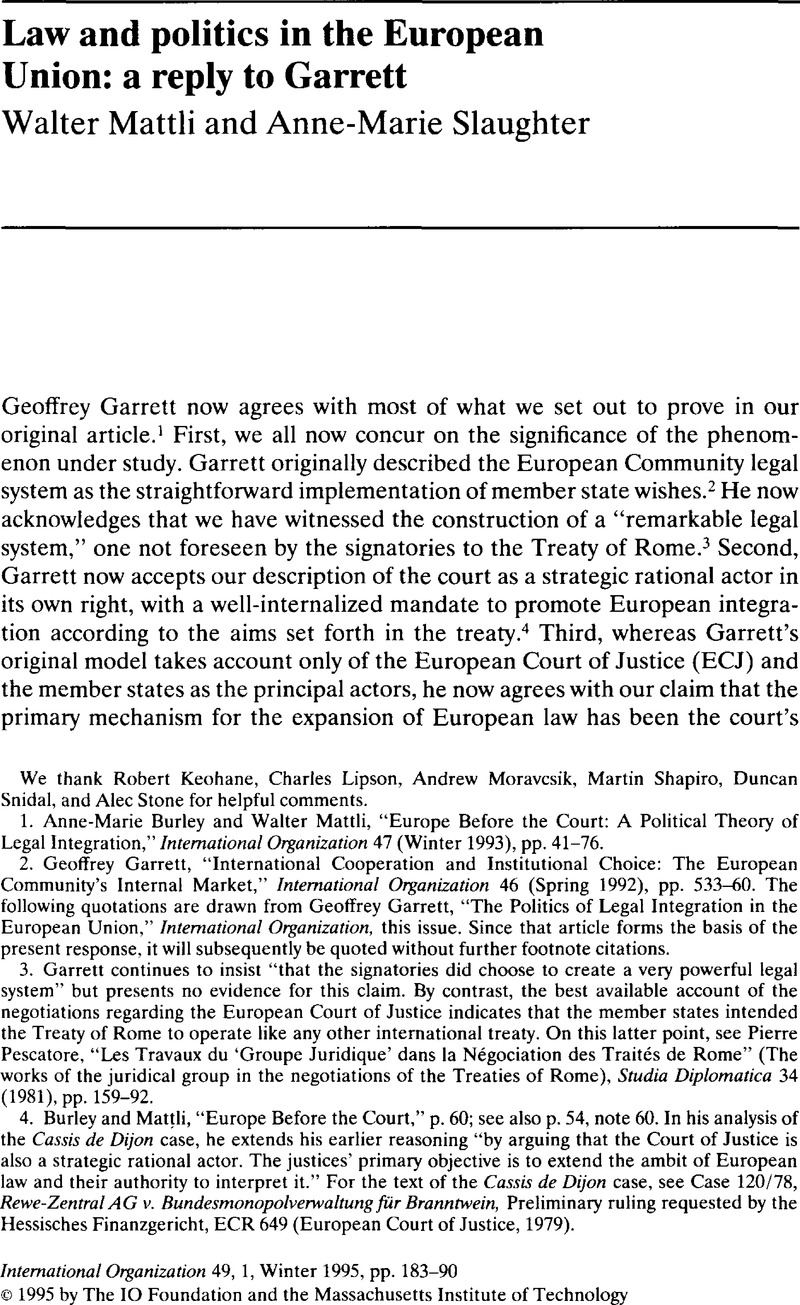Article contents
Law and politics in the European Union: a reply to Garrett
Published online by Cambridge University Press: 22 May 2009
Abstract

- Type
- Dissent and debate
- Information
- Copyright
- Copyright © The IO Foundation 1995
References
We thank Robert Keohane, Charles Lipson, Andrew Moravcsik, Martin Shapiro, Duncan Snidai, and Alec Stone for helpful comments.
1. Burley, Anne-Marie and Mattli, Walter, “Europe Before the Court: A Political Theory of Legal Integration,” International Organization 47 (Winter 1993), pp. 41–76.CrossRefGoogle Scholar
2. Garrett, Geoffrey, “International Cooperation and Institutional Choice: The European Community's Internal Market,” International Organization 46 (Spring 1992), pp. 533–60.CrossRefGoogle Scholar The following quotations are drawn from Geoffrey Garrett, “The Politics of Legal Integration in the European Union,” International Organization, this issue. Since that article forms the basis of the present response, it will subsequently be quoted without further footnote citations.
3. Garrett continues to insist “that the signatories did choose to create a very powerful legal system” but presents no evidence for this claim. By contrast, the best available account of the negotiations regarding the European Court of Justice indicates that the member states intended the Treaty of Rome to operate like any other international treaty. On this latter point, see Pescatore, Pierre, “Les Travaux du ‘Groupe Juridique’ dans la Négociation des Traités de Rome” (The works of the juridical group in the negotiations of the Treaties of Rome), Studia Diplomatica 34 (1981), pp. 159–92.Google Scholar
4. Burley and Mattli, “Europe Before the Court,” p. 60; see also p. 54, note 60. In his analysis of the Cassis de Dijon case, he extends his earlier reasoning “by arguing that the Court of Justice is also a strategic rational actor. The justices' primary objective is to extend the ambit of European law and their authority to interpret it.” For the text of the Cassis de Dijon case, see Case 120/78, Rewe-Zentral AG v. Bundesmonopolvenvaltung für Branntwein. Preliminary ruling requested by the Hessisches Finanzgericht, ECR 649 (European Court of Justice, 1979).
5. Shapiro, Martin, Courts: A Comparative and Political Analysis (Chicago: University of Chicago Press, 1981).Google Scholar
6. As noted above, Garrett's extended analysis does allow for some variance along the lines suggested by our own study.
7. Pescatore, Pierre, “The Doctrine of Direct Effect: An Infant Disease of Community Law,” European Law Review 8 (06 1983), pp. 155–77 and p. 157Google Scholar in particular. (Pescatore served on the ECJ from 1967 to 1986.) Another former judge of the court concurs: “The Court frequently goes beyond the conceptions which the member states may have had and sometimes still have, as parties to the Community treaties. As so often, the work is more belligerent than its creator and goes its own way.” See Everling, Ulrich, “The Member States of the European Community Before their Court of Justice,” European Law Review 9 (08 1984), pp. 215–41.Google Scholar The quotation is drawn from p. 217.
8. Many of the judges we cite acknowledge this point openly. See Burley and Mattli, “Europe Before the Court,” p. 71.
9. This was Eric Stein's conclusion after reviewing eleven major cases. See Stein, Eric, “Lawyers, Judges, and the Making of a Transnational Constitution,” American Journal of International Law 75 (01 1981), pp. 1–27.CrossRefGoogle Scholar
10. Burley and Mattli, “Europe Before the Court,” p. 44.11. Ernst Haas, “Technocracy, Pluralism, and the New Europe,” in Nye, Joseph, International Regionalism (Boston: Little, Brown, 1968), pp. 149–79 and p. 152Google Scholar in particular.
11. Ernst Haas, “Technocracy, Pluralism, and the New Europe,” in Joseph Nye, International Regionalism (Boston: Little, Brown, 1968), pp. 149–79 and p. 152 in particular.
12. Case 178/84, Re Purity Requirements for Beer: E. C. Commission v. Germany, ECR 1227 (European Court of Justice, 1987).
13. Foreign beer is today readily available in Germany and the volume of foreign beer imports has increased steadily ever since 1988. See Bundesministerium für Ernährung, Landwirtschaft, Forsten, Statistisches Jahrbuch über Emähmng, Landwirtschaft and Forsten (Statistical yearbook on nutrition, agriculture, and forestry) (Münster-Hiltrup: Landwirtschaftsverlag, 1993), p. 244.Google Scholar
14. To take only the most recent study, Alter and Meunier-Aitsahalia find that “Germany and France have been the strongest opponents of mutual recognition because, being high standard countries, they have the most to lose.” See Alter, Karen and Meunier-Aitsahalia, Sophie, “Judicial Politics in the European Community: European Integration and the Pathbreaking Cassis de Dijon Decision,” Comparative Political Studies 26 (01 1994), pp. 535–561CrossRefGoogle Scholar; the quotation is drawn from p. 550.
15. Arnull, Anthony, “Judging the New Europe,” European Law Review 19 (02 1994), pp. 1–15 and p. 11Google Scholar in particular.
16. “Chancellor Kohl Accuses the Court of Going Beyond its Competencies: The ‘Paletta’ and ‘Boetel’ Cases,” Europe, no. 5835, 14 10 1992, p. 9.Google Scholar
- 76
- Cited by




